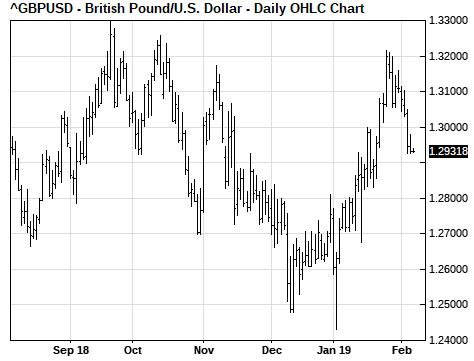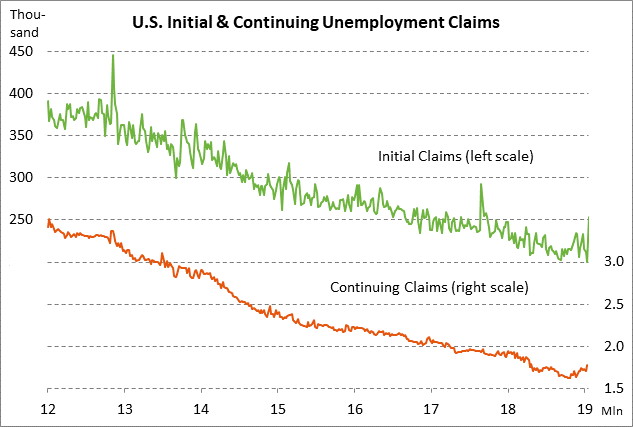- Clock ticks down for border deal to avoid new government shutdown
- Prime Minister May faces a firm “no” in Brussels today and will soon have to face Parliament
- 30-year T-bond auction to yield near 3.02%
- Unemployment claims expected to partially reverse shutdown-induced spike
Clock ticks down for border deal to avoid new government shutdown — Congressional negotiators tasked with finding a bipartisan border security deal are running out of time. House Speaker Pelosi has set a deadline of Friday for a deal, but that deadline can apparently be stretched to at least Monday. The House needs time to write the legislation and put the deal on the docket before the continuing resolution (CR) expires next Friday.
Congressional negotiators have made little progress so far on putting a deal together, raising the question about whether Congress and President Trump would be willing to approve another short-term CR to give more time to agree on a border security deal. If not, then Congress and President Trump will have to decide if they are willing to allow another partial government shutdown starting next Saturday.
Even if Congressional negotiators reach a deal on border security, the deal is not likely to include anything close to President Trump’s demand for $5.7 billion for wall funding. At most, a bipartisan agreement might throw a little money at extending border fences that are already in place.
If Congress does produce a border security compromise, then President Trump would have three options: (1) accept whatever Congress is willing to provide for border security and defer his demand for wall funding until later in the year (e.g., against the need for a debt ceiling increase around summer), (2) force another government shutdown next Saturday and see if Democrats will back down the second time around, or (3) declare a national emergency to try to get wall funding.
Mr. Trump is unlikely to get far with a border emergency declaration because of court challenges and because Congress might vote to reject the emergency since there are some Senate Republicans that are strongly opposed to a national emergency declaration. But even if the border emergency ploy doesn’t work, Mr. Trump could at least tell his base that he took aggressive action in trying to get a wall.
A U.S. government shutdown is still a possibility for next Saturday, but seems less likely this time around since Mr. Trump was forced to climb down from the first shutdown and since there is virtually no support among Congressional Republicans for a new government shutdown. A new U.S. government shutdown could grease the skids for a new U.S. stock market sell-off if it added to other bearish news such as a bad turn in the US/Chinese trade talks.
Prime Minister May faces a firm “no” in Brussels today and will soon have to face Parliament — UK Prime Minister May will meet in Brussels today with European Commission President Juncker and EU President Tusk. Ms. May is trying get the EU to relent on its Irish border backstop after Parliament last Tuesday approved a replacement of the backstop with the meaningless substitute of “alternative measures.” Since that vote, EU officials have said multiple times that they will not reopen the Brexit separation agreement and will not soften the backstop.
Ms. May seems destined to go back to Parliament empty handed regarding any EU backstop concessions that would be enough for Parliament to approve a Brexit separation deal. Ms. May last week promised that if she didn’t have a new deal by February 13 that she would allow a new Brexit vote in Parliament, such as a vote to prevent a no-deal Brexit by agreeing with the EU to extend the March 29 deadline. However, that February 13 Brexit vote may slip since Bloomberg on Wednesday quoted an unnamed UK official as saying that the next opportunity for Parliament to vote on Brexit could be delayed beyond February 13.
The betting odds are currently at 33% for the disaster of a no-deal Brexit by April 1, according to oddschecker.com.
30-year T-bond auction to yield near 3.02% — The Treasury today will conclude this week’s $84 bln refunding operation by selling $19 bln of new 30-year T-bonds. The $19 billion size of today’s 30-year bond auction is unchanged from November’s auction size since the Treasury has stopped raising the sizes of its longer-term coupons. However, today’s bond size is up by $4 billion from the $15 billion size seen as recently as late 2017.
The benchmark 30-year bond late yesterday was trading at 3.02%, near the middle of the range seen over the past three weeks. The 30-year bond yield has rebounded higher by +13 bp from the early-January 1-year low of 2.89%. The upward rebound in the 30-year bond yield during January was caused mainly by the upward rebound in global stock markets, which made the near-term economic outlook look less threatening.
The 12-auction averages for the 30-year are as follows: 2.31 bid cover ratio, $6 million in non-competitive bids to mostly retail customers, 4.4 bp tail to the median yield, 32.0 bp tail to the low yield, and 43% taken at the high yield. The 30-year is slightly below above average in popularity among foreign investors and central banks. Indirect bidders, a proxy for foreign buyers, have taken an average of 61.5% of the last twelve 30-year T-bond auctions, slightly below the median of 61.9% for all recent coupon auctions.
Unemployment claims expected to partially reverse shutdown-induced spike — The consensus is for today’s weekly initial unemployment claims report to show a decline of -32,000 to 221,000, reversing part of last week’s upward spike of +53,000 to 253,000 that was caused by the U.S. government shutdown and by volatility surrounding the Martin Luther King holiday. The consensus is for today’s continuing claims report to show a decline of -49,000 to 1.733 million, reversing part of last week’s +69,000 increase to 1.782 million.





